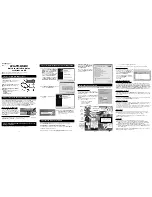
Additional preparation
33
ENGLISH
AV-32/28T4SP / LCT1571-001B-U / English
Devices which can output the S-
VIDEO signal (Y/C signal) such as
an S-VHS VCR
Connect the device to an EXT terminal other
than the EXT-1 terminal.
You can choose a video input signal from the
S-VIDEO signal (Y/C signal) and regular
video signal (composite signal). For details
of how to operate the device, see “
y
(S-
VIDEO input)” on page 29.
T-V LINK compatible VCR
Be sure to connect the T-V LINK compatible
VCR to the EXT-2 terminal. If not, the T-V
LINK function will not work properly.
• When connecting a T-V LINK compatible
VCR to the EXT-2 terminal, be sure to
connect the Decoder to the VCR. If not,
the T-V LINK function may not work
properly. After you have registered TV
channels to the Programme numbers (PR),
set the DECODER (EXT-2) function for
the Programme number (PR) to ON in
order to unscramble a scrambled TV
channel. For details of operation, see
“DECODER (EXT-2)” on page 28.
Connecting headphones
Connect the headphones with a stereo mini-
jack (of 3.5 mm in diameter) to the
headphone jack at the TV rear panel.
• No sound comes out from the TV
speakers when the headphones are
connected.
Video/sound signal output from
the EXT-2 terminal
You can arbitrarily change over the output of
the video/sound signal from the EXT-2
terminal. It is useful when you want to dub
the video/sound from another device on the
VCR connected to the EXT-2 terminal. For
details on how to do this operation, see
“DUBBING” on page 31.
TV output from the EXT-1 terminal
The output of video/sound signal of a TV
channel you are currently viewing is always
output from the EXT-1 terminal.
• Changing over a Programme number (PR)
also changes over the TV output from the
EXT-1 terminal.
• The video/sound signal from an EXT
terminal cannot be output.
• Teletext programmes cannot be output.
AV-32&28T4SP_Eng.book Page 33 Wednesday, February 25, 2004 10:05 AM









































